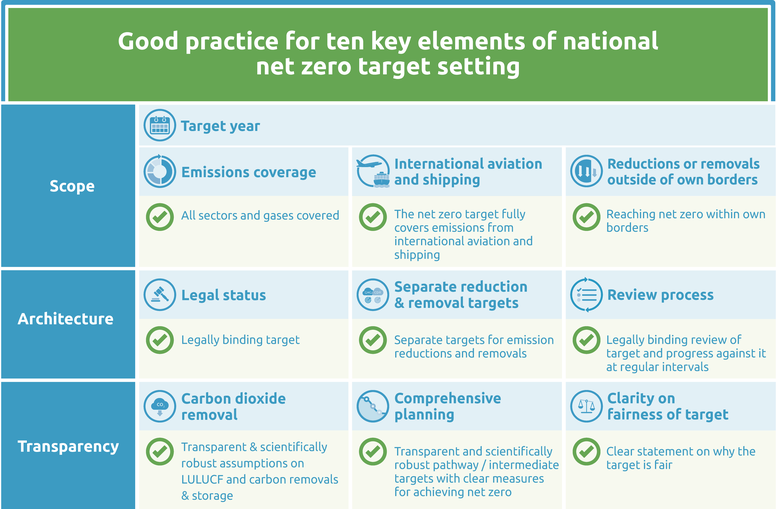Net zero targets
Summary
We evaluate the net zero target as: Poor
The Kazakh government published its Doctrine (Strategy) to Achieve Carbon Neutrality Until 2060 as a policy document in September 2021 (Republic of Kazakhstan, 2021). Kazakhstan has not submitted the strategy as an official long-term strategy (LTS) to the UNFCCC as of September 2022.
The carbon neutrality target covers the most important greenhouse gases (GHGs) and provides some assumptions on intended removals by land-based and technology-based solutions.
The Kazakh government could further improve its carbon neutrality target informed by key elements considered important by the CAT to enhance transparency, target architecture, and scope. For example, the strategy currently neither mandates a regular review cycle nor explains why it considers the target a fair contribution to the global goal of limiting warming to 1.5°C above pre-industrial levels.
Ten key elements
Scope
- Target year – Kazakhstan aims to reach carbon neutrality by 2060.
- Emissions coverage – Despite using the term ‘carbon neutrality’—indicating the coverage of CO2 emissions only—the CAT assumes that Kazakhstan’s target covers all GHG emissions due to the use of ‘GHG emissions’ and ‘CO2eq’ throughout the strategy. For the waste sector in particular, the Kazakh government specifies the coverage of CO2, CH4, and N2O emissions. Across all sectors, CO2, CH4 and N2O represent more than 99% of Kazakhstan’s total emissions in 2019 using latest available PRIMAP historical data (Gütschow et al., 2021). The target also covers all sectors of the economy.
- International aviation and shipping – Kazakhstan provides no information on its intention to cover international aviation and shipping.
- Reductions or removals outside of own borders – Kazakhstan provides no information on its intention to use international offset credits to meet its net zero target
Target architecture
- Legal status – The Kazakh government published its strategy to achieve “carbon neutrality” until 2060 as a policy document in September 2021 (Republic of Kazakhstan, 2021). Kazakhstan has not submitted the strategy as an official long-term strategy (LTS) to the UNFCCC as of September 2022.
- Separate reduction & removal targets – Kazakhstan does not provide separate emission reduction and removal targets.
- Review process – Although Kazakhstan emphasises the overall importance of reviewing the current target and strategy, it provides no further information on its intention to establish a regular and legally binding review cycle.
Transparency
- Carbon dioxide removal – Kazakhstan provides detailed estimates for GHG emissions from LULUCF, which will become a net sink by 2030 in all scenarios. In the ‘carbon neutrality’ scenario, land-based sinks reach 20 MtCO2e in 2030 and 45 MtCO2e in 2060. Kazakhstan makes a loose reference to carbon dioxide removal to account for the remaining 31 MtCO2e in absorptions needed in 2060 to become net zero but does not provide specific planning for it.
- Comprehensive planning – Kazakhstan provides a detailed and transparent emissions pathway to reach carbon neutrality by 2060, displaying emissions in 10-year intervals. The Kazakh government commits to reducing emissions in the heat and electricity sectors by 94% between 2017 and 2040.
With 39% of total GHG emissions in 2017, the heat and electricity sector is currently the highest emitting sector (Republic of Kazakhstan, 2021). The government intends to achieve these emissions reductions by increasing the use of renewable energy and CCS. In the ‘Carbon neutrality’ scenario, the share of renewable energy in primary energy supply climbs from only 2% in 2020, to 31% in 2040 and 72% in 2060.
Kazakhstan provides transparent pathways for the use of CCS technologies, highlighting the fact that CCS can only be an intermediate technology on its way to decarbonisation. CCS reaches a coverage of 99.5% of fossil fuel emissions in 2060.
In 2040, captured emissions are divided into 49 MtCO2e from the heat and electricity sector and 4.6 MtCO2e from the industry sector. Both sectors will rely on CCS activity at decreasing rates over time due to limited storage capacities. The level of CCS in the heat and electricity sector will be reduced to 19 MtCO2e annually and in the industry sector to 3.3 MtCO2e annually. - Clarity on fairness of target – Kazakhstan makes no reference to fairness or equity in the context of its net zero target.
Good practice
The Climate Action Tracker has defined the following good practice for all ten key elements of net zero targets. Countries can refer to this good practice to design or enhance their net zero targets.
Further analysis
Latest publications
Stay informed
Subscribe to our newsletter





